13.12.2011
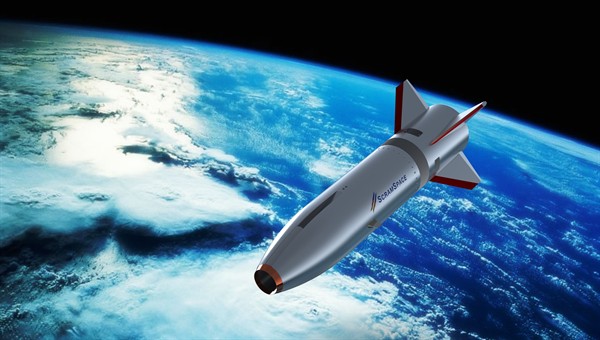
Können neuartige Triebwerke den Flug ins All leichter und preiswerter machen? Dieser Frage gehen Forscher des Deutschen Zentrums für Luft- und Raumfahrt (DLR) in einem der europaweit bedeutendsten Hyperschallwindkanäle in Göttingen nach. Sie testen den Antrieb des australischen Experimental-Raumfahrzeuges SCRAMSPACE 1, das 2013 starten soll.
Flug bei 10-15facher Schallgeschwindigkeit?
Dabei handelt es sich um einen so genannten Scramjet (Supersonic Combustion Ramjet – Staustrahltriebwerk mit Überschallverbrennung). Das ist ein Triebwerk, das Hyperschallflüge bis Mach 15 ermöglichen soll. Im Gegensatz zu normalen Düsentriebwerken gibt es keine beweglichen Teile. Dafür muss ein Scramjet erst auf Hyperschallgeschwindigkeit beschleunigt werden, um zu funktionieren.
Australien gilt als eines der führenden Länder in der Erforschung der Scramjet-Technologie. In einem Flugversuch wurde dort 2002 erstmals die Funktionsfähigkeit einer Scramjet-Brennkammer nachgewiesen. Bereits damals war das DLR beteiligt.
Potentielle Vorteile von Scramjets
Die Australier setzen in Scramjets große Erwartungen für die Zukunft der Raumfahrt. „Sie könnten die Effizienz und Zuverlässigkeit erhöhen und die Kosten senken“, hofft SCRAMSPACE-Projektleiter Professor Russell Boyce von der Universität Queensland. Der Vorteil von Scramjets: Da sie den Sauerstoff aus der Luft nehmen, braucht er nicht mittransportiert zu werden. Nach den Vorstellungen von Boyce würde ein Scramjet idealerweise mit einer mehrstufigen Rakete kombiniert werden.
Weiter geht es hier:http://www.dlr.de/dlr/desktopdefault.aspx/tabid-10081/151_read-2274/
Fotos: DLR
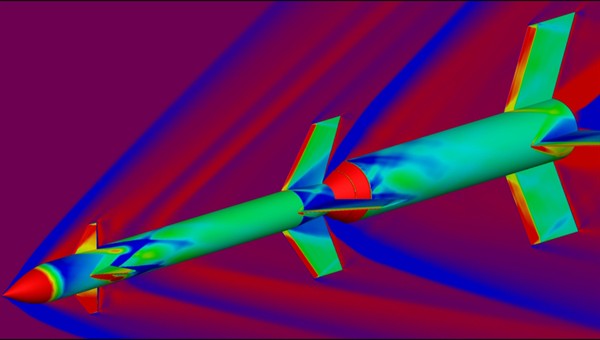
.
Update: 25.08.2013
.
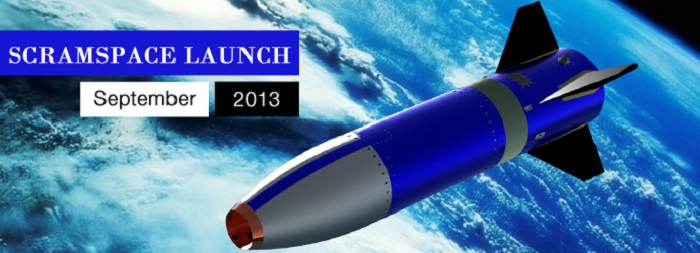
Sending 'Scramspace' out of this world
A small team from the University of Queensland are preparing to launch a hypersonic scramjet, which could ultimately change the way we travel.
In September the team from the University of Queensland (UQ) will launch the 1.8 metre hypersonic scramjet 'Scramspace 1' from the Andoya Rocket Range in the Arctic regions of Norway in an experiment that will bring Australia one step closer to designing "vehicles of the future".
On launch day rockets will boost 'Scramspace 1' to an altitude of 80km where it will detach and become a free-flying scramjet.
Momentum will carry it to 340km above the Earth, where the real test will last just three seconds as the jet swan dives back to earth eight times faster that the speed of sound, melting at re-entry.
Professor Boyce, head of the Scramspace 1 project and chair of hypersonics at UQ says the project will ultimately test everything from high-temperature materials that could change the face of manufacturing industries to the viability of putting satellites into space for around half the cost.
"We have a vision...it's possible that we might even be able to put satellites into space for half the cost.
"If you take out one of the rocket stages and put in a scramjet instead, the efficiency goes up and the cost goes down remarkably," Professor Boyce says.
But if the prospect of a satellites and an air-breathing jet engine shooting up into the exoatmosphere (or out of the earth's atmosphere) at Mach 8 speed (that's eight times faster than the speed of sound) doesn't interest you - perhaps the impact this technology will have on air travel might.
"Travelling at that speed could mean a 45 minute flight between Australia and South Africa," according to Professor Boyce, but probably just not for another 50 years.
"Maybe we'll see operational vehicles in the next decade, but to put people on it...as NASA has found out, the difference between flying a rocket into space and flying people into space on that rocket, is a whole new ball game."
The project, which was established with funding by the Australian Space Research Program, is also developing technologies which have applications outside of the aerospace industry.
"On the flight experiment there are some high-temperature materials, some ultra-high temperature ceramic materials being tested. These are useful for not just for high speed flight, but for high temperature manufacturing," Professor Boyce says.
Inside mission control
The team's Technical Lead Dr Sandy Tirtey is in charge of making sure the Scramspace 1 jet is in shape to perform the experiment in Norway, even at T minus one minute.
Inside a small mission control room from the test site Dr Tirtey will communicate with each workstation responsbile for a different part of the flight experiment.
"There are plenty of things that can go wrong. The last two minutes are very intense. No one touches the computer, we're just monitoring. And I am disconnecting every single system that is connected to the payload."
"This is a process where you have to be very quiet and very focussed on what you are doing. So if it goes to plan we will be cheering at every single step!"
Ahead of the pack
This is not the first time the hypersonics team at UQ have made hypersonic waves.
In 2002 the UQ's HyShot program beat NASA to perform the first successful test flight of a scramjet.
Dr Tirtey believes Australia has a unique position in the field due to the team's work with 'Scramspace 1'.
"I think Australia has a card to play in the world of hypersonics," he says, "because the approach we have taken is very novel. We have a small team, controlling every single aspect, so we have this project really well in hand."
He says his former employer, the European Space Agency, would have taken 10 years and 10 times the budget to accomplish what the team at UQ have in three years.
According to Professor Boyce most flight experiments of this nature take a lot longer, and cost more than the $3.5 million price tag attached to Scramspace.
.

.
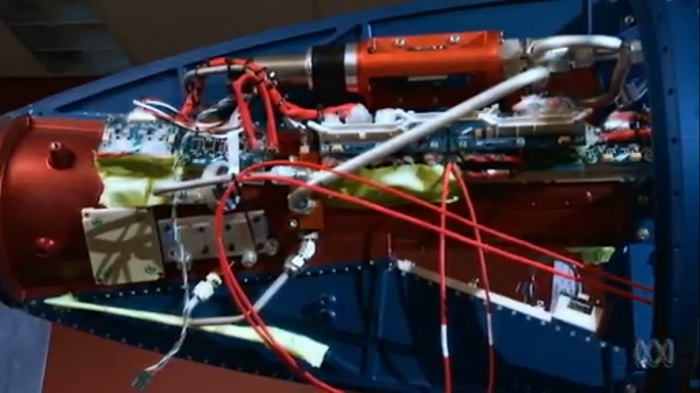
.
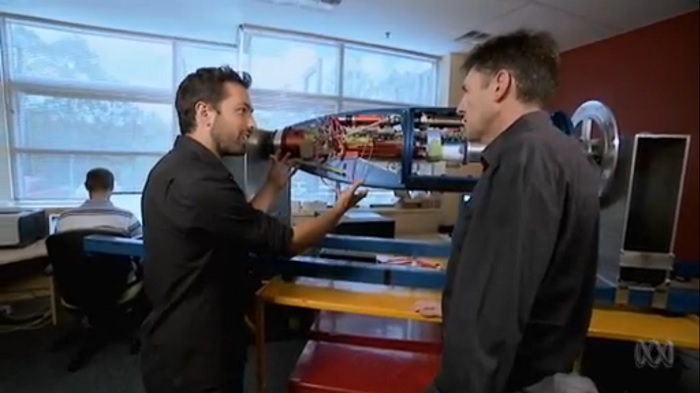
.
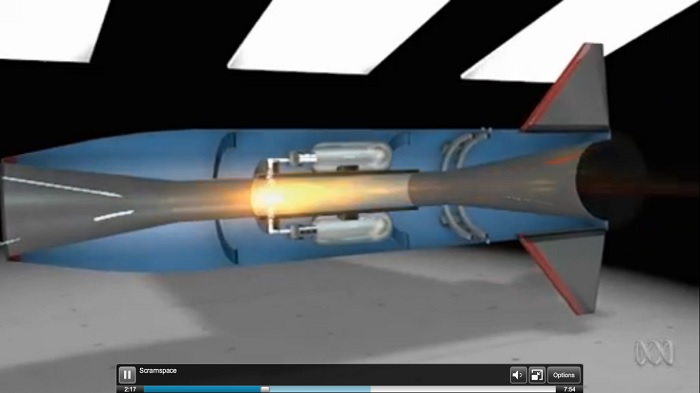
.
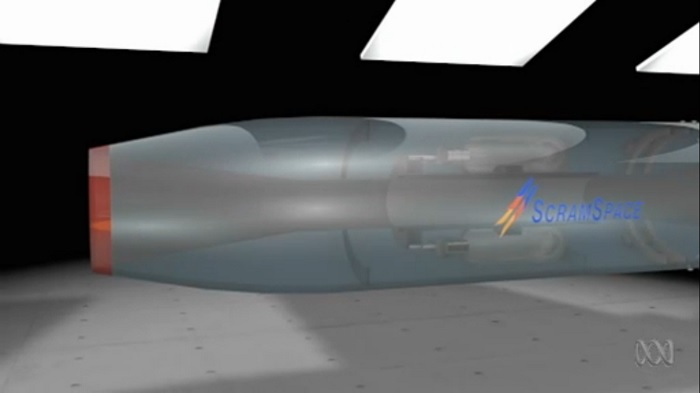
.
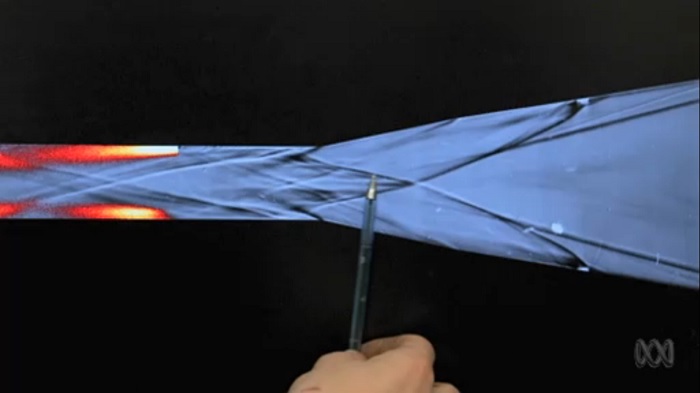
.

.
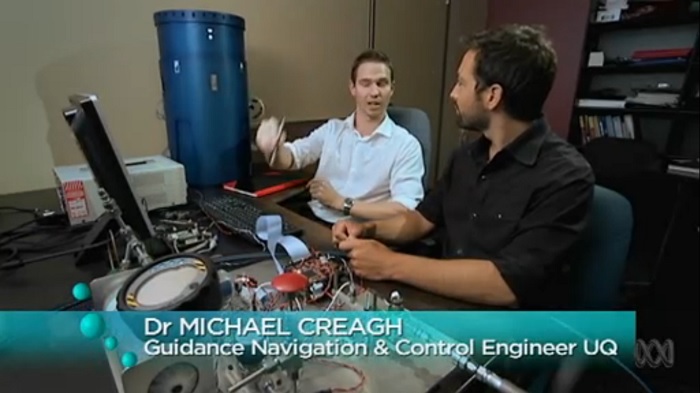
.
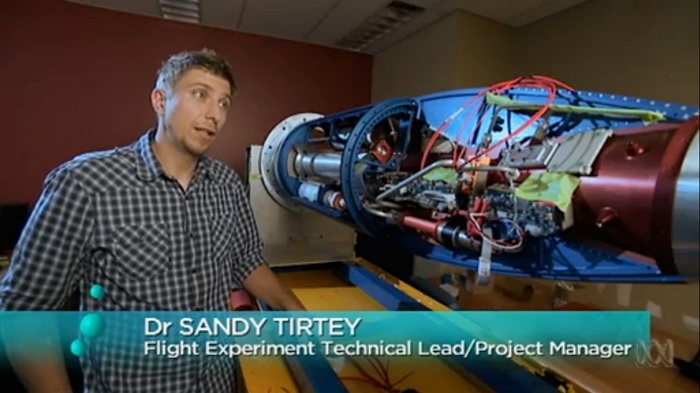
.
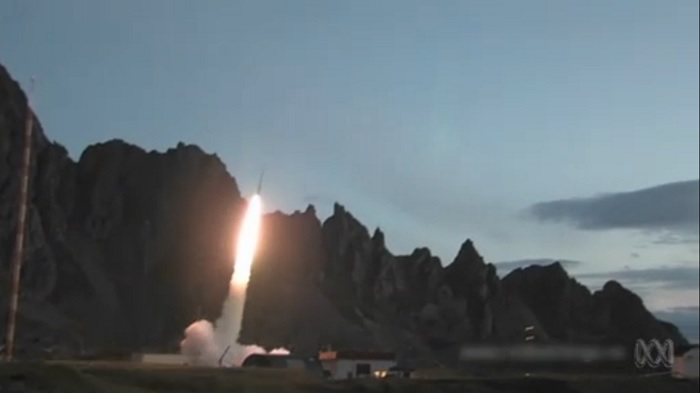
.

Dr Sandy Tirtey and Professor Russell Boyce with Scramspace 1 at the University of Queensland. The scramjet engine is shown to the public for the last time before the Norway launch in September. (Emma Sykes - ABC Multiplatform)
Quelle: ABC Brisbane
.
About the Project
The SCRAMSPACE project was established with $5 million Commonwealth funding through the Australian Space Research Program. The project forms the hub of a capability for ongoing scramjet flight programs to contribute to the talent pool for future flight tests and the Australian space and aerospace industry. It has already achieved success in this with a cohort of highly talented people assembled to work on the project.
By addressing key scientific and technological questions, the consortium is conducting a flight-test of a free-flying scramjet at Mach 8, and ground-tests at up to Mach 14.
.
SCRAMSPACE - the next frontier
The research is the first phase of SCRAMSPACE - the development of a high-tech Australian capability set to revolutionise the way the world launches satellites into space.
“A scramjet is an airbreathing engine for hypersonic craft that travel at many times the speed of sound, for high speed transport in Earth's atmosphere or along trajectories to space, Professor Russell Boyce said.
"They improve the efficiency and reliability and reduce the cost of inserting satellites into orbit."
Professor Boyce is the SCRAMSPACE director and Chair in Hypersonics at UQ.
“Australia is a world leader in scramjet development," he said.
"We now have an opportunity to build a scramjet-based industry in this country, in international partnership.
"The SCRAMSPACE project is building capacity and capability towards such an industry.
“The flight team is supported by scramjet specialists at UQ's Centre for Hypersonics and the Defence, Science and Technology Organisation's (DSTO) Applied Hypersonics Branch in Brisbane.
"Several PhD students are contributing to the technology."
Professor Boyce said the SCRAMSPACE project had been established with Commonwealth funding to form the hub of a capability for ongoing space-access flight programs and to contribute to the talent pool for a future Australian space industry.
In line with that, the Australian aerospace industry was playing a key role in the project.
He said that including new researchers in support activities around the country, nine professional positions had resulted already.
The next phase of SCRAMSPACE is already on the drawing board.
If funded, graduating students will be channelled into the team to bring it to the critical mass necessary to develop the capability, and to assist Australia's aerospace industry to eventually corner part of the world's multi-billion dollar space market.
"In the meantime, it establishes partnership with the key players internationally from whom other space-related technologies can be accessed," he said.
"Very importantly, it gives us a voice in the international space arena, to be able to participate in discussions on space regulations and activity that will affect us.”
Professor Boyce said that Australia depended heavily on space-based technologies.
“In the coming years and decades, Australia needs secure and assured access to the space environment and to the workhorse applications of space, for satellite communications, remote sensing, and timing and positioning information,” he said.
“These will play important roles in Australia's future development.
“We are dependent on space, yet far from self-sufficient, and the fragile space environment is congested and cluttered with debris. For both reasons, we are vulnerable.
“We need to be able to provide leadership in the councils which regulate the space environment and space activities, in order to minimise our current vulnerabilities in space.
“This access and leadership will depend on Australia's international space credentials, the prerequisites for which will be demonstrable capability and commitment in the space arena.
“Building capacity for a scramjet-based small satellite launch capability and industry will assist Australia's credentials enormously.”
Today the scramjet, SCRAMSPACE I, is on track for launch at Woomera in South Australia late next year, having just passed a major design review.
According to Dr Sandy Tirtey, the Technical Lead and focal point of the new team, the scramjet has passed its preliminary concept development phase.
“We have another design review set for July and are aiming at the Critical Design Review in October this year," Dr Tirtey said.
"After that, we start the process of manufacture, assembly, and extensive pre-flight tests.”
The 1.8 metre long scramjet vehicle will be boosted by two rockets to about 340km above the Earth.
After leaving the atmosphere, the scramjet will be separated from the rocket, and the fins that will keep it stable on its return through the atmosphere will be deployed and locked.
On its way down, the bullet-shaped vehicle will be accelerated by gravity to Mach 8, and the experiment will take place between 32km and 27km above the Earth.
The flight will include experimental diode laser flight instrumentation and advanced high temperature materials with embedded sensors.
In parallel, scramjet concepts will be tested at even greater speeds — up to Mach 14 — in UQ's world-class hypersonic ground-test facilities, and simulated with supercomputers.
This first phase of SCRAMSPACE is the largest project, “Scramjet-based Access-to-Space Systems”, to be funded under the Commonwealth government's Australian Space Research Program (ASRP).
SCRAMSPACE has attracted 5 million dollars of ASRP funding and is also supported by nine million dollars from an international partnership consortium.
The 13-member international consortium is led by UQ.
Partners in the program include four Australian universities — UQ, the University of New South Wales, the University of Adelaide, and the University of Southern Queensland; and a US university, the University of Minnesota.
It also includes space agencies and research organisations from Germany, Japan and Italy respectively ; DSTO; the Australian Youth Aerospace Association; and industry partners including Brisbane firm Teakle Composites Pty Ltd, Cairns firm AIMTEK Pty Ltd, and BAE Systems.
Professor Boyce said the project was 12 months old and "going like a scramjet".
SCRAMSPACE scramjet flight gets the green light

It's all systems go for the experimental SCRAMSPACE scramjet flight, which passed its Critical Design Review in Brisbane recently.
SCRAMSPACE is a free-flying hypersonic scramjet which will fly at 8600km/h next year, at the Andøya Rocket Range 300km north of the Arctic Circle in Norway.
A $14 million international consortium of partners in five countries, led by The University of Queensland's Centre for Hypersonics, is behind the project, which is developing a new type of scramjet.
The project has enabled a flight team of 10 talented scientists and engineers to assemble at UQ, supported by the research of a further thirteen PhD students and postdocs.
Seven more are working on the project at partner universities: the University of New South Wales, University of Adelaide, and University of Southern Queensland.
Scramjets are air-breathing engines capable of travelling at hypersonic speeds.
They offer a safe, reliable and economical means for launching satellites into space.
Australia depends critically on satellites for communications, navigation, remote sensing, and much more.
SCRAMSPACE Director and Chair for Hypersonics at UQ Professor Russell Boyce said that passing the review under the scrutiny of the Defence Science and Technology Organisation (DSTO) and others was a major project milestone.
“The SCRAMSPACE flight team has done an incredible job so far," he said.
“With training and support from our colleagues at DSTO, a state-of-the-art experimental scramjet vehicle has been fully designed, on time and on budget.
“Scramjets and hypersonic flight are the next big step for aerospace.
"As we tackle this challenge, the SCRAMSPACE team represents the talent pool needed to take our science and technology to the sky in future flight tests.”
The flight experiment Technical Lead, Dr Sandy Tirtey, described the next phase of the project as critical.
“It's a very exciting stage in the project," he said.
"Our team now has a big effort ahead in manufacture, assembly and pre-flight testing to be able to fly next year.
“This will include installation of special high temperature ceramic components from our partners in Germany and Italy, a high temperature carbon-fibre thrust nozzle from another partner, Teakle Composites in Brisbane, and a laser flight instrument from UNSW.
"The pre-flight testing is extremely important, and will be supported heavily by our major industry partner BAE Systems.
"They have developed a sophisticated Hardware-in-the-Loop test capability, and will put the payload through a series of virtual missions in order to detect any faults."
The research surrounding SCRAMSPACE is also going well.
Fundamental scramjet research has been conducted in UQ's T4 shock tunnel, as well as the very large shock tunnels at the German Aerospace Center (DLR) in Göttingen, Germany and at the Japanese Aerospace Exploration Agency (JAXA) near Sendai, Japan.
Ground tests at USQ's hypersonic wind tunnel and UQ's X3 expansion tunnel will begin soon, followed by materials testing in a plasma hypersonic wind tunnel at the Italian Aerospace Research Center (CIRA) near Naples in Italy.
“X3 is the only facility in the world that can be used for testing meaningful scale scramjets at very high flight speed and at the actual dynamic pressures experienced by vehicles on ascent-to-space trajectories," Professor Boyce said.
"We've been assisted in this with infrastructure contributions from our partner AIMTEK.”
The research also makes intensive use of Australia's supercomputing research infrastructure to perform computational studies of the complex scramjet flow processes.
The flight team, aside from Professor Boyce and Dr Tirtey, includes Dr Melrose Brown, Dr Michael Creagh, Dr Bianca Capra, Igor Dimitrijevic, Paul van Staden, Amy Dedman, Brad Sharp and Adrian Pudsey.
The SCRAMSPACE flight experiment
The 1.8-metre-long spacecraft will be transported to an altitude of 340 kilometres by a two-stage rocket. After leaving the atmosphere, the scramjet vehicle will separate from the rocket, and orient itself for the re-entry with small thrusters.
During the return flight, the vehicle will be accelerated by gravity to Mach 8 – about 8600 kilometres per hour.
The part of the experiment important to the scientists takes place at an altitude of between 27 and 32 kilometres. This is where the scramjet's hydrogen fuel will be injected, and a wide range of instruments will analyse the combustion and measure thrust.
About the project
The SCRAMSPACE project was established with $5 million Commonwealth funding through the Australian Space Research Program.
The project forms the hub of a capability for ongoing scramjet flight programs to contribute to the talent pool for future flight tests and the Australian space and aerospace industry.
It has already achieved success in this with a cohort of highly talented people assembled to work on the project.
By addressing key scientific and technological questions, the consortium is conducting a flight-test of a free-flying scramjet at Mach 8, and ground-tests at up to Mach 14.
Partners in the program include four Australian universities — UQ, the University of New South Wales, the University of Adelaide, and the University of Southern Queensland; and a US university, the University of Minnesota.
It also includes aerospace agencies and research organisations from Germany (DLR), Japan (JAXA) and Italy (CIRA); DSTO; the Australian Youth Aerospace Association; and industry partners including Brisbane firm Teakle Composites Pty Ltd, Cairns firm AIMTEK Pty Ltd, and BAE Systems.
.
Exotic Italian research hitches a ride on UQ hypersonic scramjet
An exotic ceramic material that could one day be used to build hypersonic flight craft will be hitching a ride on a free-flying scramjet flight experiment built by The University of Queensland's SCRAMSPACE flight team.
Scientists from the Italian Aerospace Research Center (CIRA) were in Brisbane recently to install two winglets made from Ultra High Temperature Ceramic (UHTC) onto the outer skin of the scramjet, in preparation for a test flight in Norway later this year.
The flight, SCRAMSPACE I, is one of the activities of the international 13-partner $14M SCRAMSPACE Scramjet-based Access-to-Space Systems project, part funded by the Australian Space Research Program.
Scramjets are air-breathing engines capable of travelling at hypersonic speeds.
SCRAMSPACE I will be boosted to these speeds by a two-stage rocket that launches the scramjet out of the atmosphere and into space. The rocket will be launched by the Mobile Rocket Base (MORABA) of the German Aerospace Center (DLR), one of the SCRAMSPACE partners.
After leaving the atmosphere, the 1.8m scramjet vehicle will separate from the rocket and orient itself for the re-entry with small thrusters. During the descent, the vehicle will be accelerated by gravity to Mach 8 – about 8600 kilometres per hour. The actual experiment takes place when the scramjet has dropped to altitudes where there is enough air to enable the engine to operate.
Dr Sandy Tirtey, Project Manager and Technical Lead for the flight experiment, said the scramjet would reach tremendous speeds that create extreme heat, so it was the ideal opportunity to test the material in a true flight environment.
“When the jet turns to come back to earth, it reaches speeds of Mach 8 (8600km/h) in the atmosphere. When reaching the denser part of the atmosphere on its way down, it starts to heat up very quickly, up to 1500 degrees Celsius, ” Dr Tirtey said.
Lab tests have already proven that the UHTC can withstand a temperature of 2000 degrees Celsius, and functional testing is a vital next step in establishing its suitability for practical application.
According to SCRAMSPACE Director and Scientific Lead for the flight, Professor Russell Boyce, it will take advantage of the rare opportunity to test not only Australia's world-leading scramjet science in hypersonic flight conditions, but also high temperature materials and construction methods, advanced avionics, instrumentation and telecommunications.
For example, The University of New South Wales (UNSW) will use the flight to test a diode-laser-based flight-conditions monitor, and a high temperature carbon-fibre thrust nozzle from Teakle Composites in Brisbane will be important to ensure the outcomes of the flight.
A collection of in-flight temperature and pressure sensors will enable the rapid collection of all necessary data before the scramjet disintegrates as it reaches dense air at low altitude.
“The scramjet is not designed to survive, but the spirit of the project is to get the data that will demonstrate that all the tools we have been working on for the last few years are working,” Dr Tirtey said.
CIRA Thermo-Structural expert Dr Roberto Gardi said the UHTC ceramic would not melt, but it could break, so researchers need to find ways to attach the brittle ceramic to more conventional materials.
“We want to have the structural behaviour of metal and the thermal protection of ceramic – the best of two worlds,” he said.
The CIRA team, together with UQ's flight team, worked together to attach the ceramic in the form of two small “winglets”, about the size of a door handle, onto the outer shell of the scramjet. After screwing it into place, they then had to painstakingly remove any protrusion.
“It is important to have a smooth surface, since a local imperfection can cause much heating. A protrusion of even 0.1mm can cause heating of up to 10 times – and burn the surface,” said Dr Gardi.
“Everything we do takes a lot of time. We need to be sure nothing is going to come loose because of vibrations. We only get one shot.”
The ultimate aim is to find materials that can be used to build parts for practical applications such as hypersonic aircraft for passenger flight and for transporting satellites to orbit efficiently and quickly.
Theoretically, hypersonic passenger aircraft could fly up to Mach 6, 7 and beyond, Dr Tirtey said.
“The hypersonic planes of the future will have a sharp shape such as the Concorde (which reached speeds of Mach 2), but the nose will be the hottest part, as well as the edge of the wings. So we need a different material to make these parts,” Dr Tirtey said.
Quality Assurance and Project Manager for CIRA's winglets, Dr Antonio Del Vecchio, said the test flight was a golden opportunity.
“It is not easy to have access to space flight, so experimenting is not easy,” he said.
It would be CIRA's second flight test on ceramic space flight materials since the research started in the 1960s. The first was in 2010 in Sweden.
About the SCRAMSPACE project
SCRAMSPACE was the first and largest project funded by the Australian Space Research Program. Building on Australia's world-class hypersonics heritage, its core objective is to build capacity and capability, in particular a talent pool, for the Australian space and aerospace industry.
This is achieved partly by means of the Mach 8 flight experiment, for which a team of exceptional young scientists and engineers has been assembled, and partly through extensive ground-based research involving many PhD students at UQ and partner universities.
Partners in the program include four Australian universities — UQ, UNSW, the University of Adelaide and the University of Southern Queensland — and a US university, the University of Minnesota.
It also includes Australia's Defence Science and Technology Organisation, who have assisted with training and access to equipment; industry partners BAE Systems, Teakle Composites and AIMTEK; aerospace agencies and research organisations from Germany (DLR), Japan (JAXA) and Italy (CIRA); and the Australian Youth Aerospace Association.
CIRA
CIRA was created in 1984 to manage PRORA, the Italian Aerospace Research Program, and uphold Italy's leadership in Aeronautics and Space.
CIRA is a company with public and private sector shareholders. The participation of research bodies, local government and aeronautics and space industries sharing a common goal has led to the creation of unique test facilities, unmatched anywhere in the world, and of air and space flying labs.
The CIRA is located in a 180-hectare area north of Naples. It has a staff of 320, most of whom are engaged in domestic and international research.
.
SCRAMSPACE Fact Sheet
SCRAMSPACE Fact Sheet
What is SCRAMSPACE?
- SCRAMSPACE is a 1.8 metre-long free-flying hypersonic scramjet – and the research project that surrounds it.
- Scramjets are air-breathing engines that travel at hypersonic speeds.
- The SCRAMSPACE is designed to operate at 8600km/h or eight times the speed of sound (Mach 8).
What happens now?
- All going well, in August 2013, the scramjet will be carefully packaged and sent, via air post, 14,600km away to Norway.
- The scramjet will reach an altitude of 340 kilometres by a two-stage rocket. After leaving the atmosphere, it will separate from the rocket and reorient for re-entry.
- On the return flight, the team will have a three-second window to collect key data from various flight sensors, before the scramjet disintegrates.
- This data will provide insights into hypersonic physics, hypersonic combustion, performance of materials and components and how hypersonic vehicles will be designed to fly in the future.
- Lab tests on the various test components have so far been positive, but the real-life launch is considered the ultimate test.
Other background
- SCRAMSPACE was the first and largest project funded by the Australian Space Research Program.
- Australia has a reputation for world-class hypersonics.
- The team is a $14 million international consortium of partners in five countries, Australia, Germany, Italy, Japan and USA, and led by The University of Queensland's Centre for Hypersonics.
- The core objective is to build capacity and capability, in particular a talent pool, for the Australian space and aerospace industry.
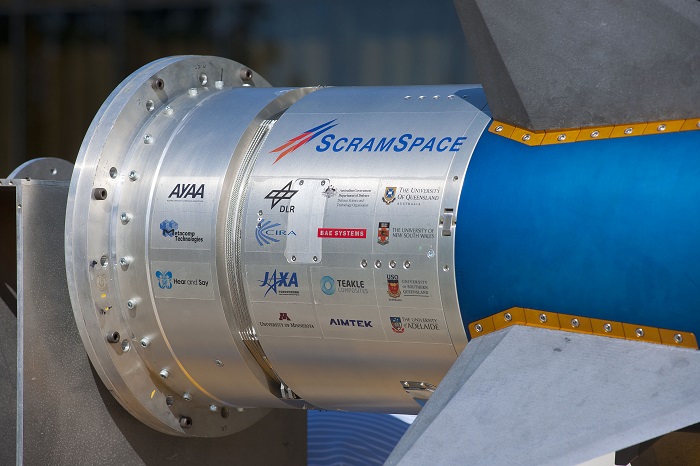
- Quelle: Centre for Hypersonics
Australia’s scramjet experiment has been discontinued
The team can confirm the launch took place and both the first and the second stages of the launch have landed safely in the water.
However it appears at this stage that the payload did not reach the correct conditions to begin collecting data as planned.
SCRAMSPACE Director, Professor Russell Boyce said the team was disappointed that the project had been discontinued and is investigating the cause.
The research project, led by The University of Queensland, aims to improve access to critical space-based technologies such as remote sensing, satellite communications and position, navigation and timing.
